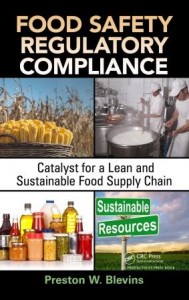Preston Blevins career spans over forty-five years with two related careers. The first as a manufacturing operations and supply-chain practitioner, and the second in the ERP/supply-chain software industry. Blevins has authored more than fifty conference white papers and magazine articles. Topics covered in these publications include Advanced Master Scheduling (and S&OP), complex manufacturing (ET0), service centric manufacturing, the food supply-chain, and industrial Eco-sustainability. 
Most recently,he authored the textbook Food Safety Regulatory Compliance: Catalyst for a Lean and Sustainable Food Supply Chain (Resource Management). This is an excerpt from next weeks Business901 podcast:
Joe: In your book you broke down the sections very well and as you said earlier certain people will look at ERP, certain people will look at sustainability; certain people will look at the supply chain. Who did you think will really benefit the most from the book?
Preston: If I’m a major supplier, and I have a myriad of small to medium sized suppliers. I want to cultivate my supply chain because that’s my value chain, right? I want to cultivate that, so I want a system, and I think Toyota, using a different out of industry analogy, outside of food, did a great job in creating Toyota City where they cultivated a supply chain. Every company within that supply chain was coached. So suppliers could use the book in many ways to start the process of improving their operating environment and their ability to economically comply with food safety requirements.
If you’re a tier two or three supplier, you would benefit. When I spent time at BatchMaster, I ran into all kinds of small food companies. They are operating on spreadsheets, and they don’t know what to do and they’ve got six or seven spreadsheets and legacy accounting system and everybody is running around, everything’s just not integrated. They’re very inefficient so they would benefit from the book.
I think the one thread that is very consistent in my mind is there’s one chapter where I took the top 10 issues in food. I applied cause and effect thinking to it. I think that’s lacking in the United States in general. We’re all kind of formula based; calculation based, methodology based and we really don’t try to sit down and think through what is the root cause of the problem. If you remember that chapter, what I did is, I laid out strategies for each of the 10 issues. What we really found was that eight of the 10 issues were all interrelated, and there was a logical starting point and a logical ending point, which in this case, happened to be food safety. So cause and effect thinking, just getting people to say, ‘wait a minute, maybe we need to cultivate some skills and inclinations within our organization that’s a little bit different from traditional approaches.’ I think that was helpful.
The other one that I felt very strongly about particularly when you get down to small to medium sized food companies is they can’t recruit a lot of talent. Food industry isn’t as glamorous as going into aerospace or defense or making the latest, greatest computer software. I really went into work force development and how you would upgrade a work force and cultivate a high performance work force from individuals who had a modest education. Work force development is another major benefit to get that thinking going that you got to work with what you have.
You look at all the Lean techniques; cause and effect thinking is very sympathetic to Lean or vice versa. They’re really interrelated. Techniques like value stream mapping, spaghetti diagrams’ talking Lean now, Kaizen events, those are all things that our work force can be trained to do. Infuse them with this idea that a day to day improvement is part of the culture, and it’s a good thing for them and everyone.
The takeaway would be the cause and effect thinking, and the beneficiaries are really the supply chain mastering in all the participants and also the idea that work force development is critical to future success. Again going back to that FDA report where they talked about continuous productivity improvement as the only survival strategy that will work for North American food companies, they actually come out and said that. This all contributes that continuous productivity is needed.
